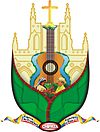Chipatá, Santander facts for kids
Quick facts for kids
Chipatá
|
|||
|---|---|---|---|
|
Municipality and town
|
|||
|
|||

Location of the municipality and town of Chipata in the Santander department of Colombia
|
|||
| Country | |||
| Department | Santander Department | ||
| Province | Vélez Province | ||
| Founded | 8 March 1537 | ||
| Founded by | Gonzalo Jiménez de Quesada | ||
| Area | |||
| • Municipality and town | 94.17 km2 (36.36 sq mi) | ||
| • Urban | 14.12 km2 (5.45 sq mi) | ||
| Elevation | 1,820 m (5,970 ft) | ||
| Population
(2015)
|
|||
| • Municipality and town | 5,088 | ||
| • Density | 54.030/km2 (139.937/sq mi) | ||
| • Urban | 688 | ||
| Time zone | UTC-5 (Colombia Standard Time) | ||
| Website | Official website: http://www.chipata-santander.gov.co/ | ||
Chipatá is a small town and a municipality (which is like a local government area) in the country of Colombia. It is located in the northeastern part of Colombia, in a region called the Santander Department. The town itself sits high up, about 1,820 meters (5,971 feet) above sea level.
Chipatá is part of the Vélez Province. It is about 227 kilometers (141 miles) from Bucaramanga, the capital city of the Santander Department. It is also about 237 kilometers (147 miles) from Bogotá, the capital city of Colombia. The municipality shares its borders with several other towns, including Vélez, La Paz, San Benito, Güepsa, and Barbosa.
Contents
What Does the Name Chipatá Mean?
The name Chipatá comes from the Chibcha language, which was spoken by the native people of this area. It is named after a local leader called cacique Chipatá. In Chibcha, the name means "farmland of our father."
- Chi means "our"
- Pa means "father"
- Tá means "farmland"
A Look at Chipatá's History
Early Inhabitants: The Muisca People
Before the Spanish arrived, the area where Chipatá is now located was part of the land of the Muisca people. The Muisca were a large group of indigenous people who lived in the central highlands of Colombia. The Chipatá area was one of the northernmost parts of their territory.
The Muisca lands were bordered by the Guane people to the north and east. The Muisca had a system where different areas were ruled by their own leaders, called caciques. The cacique of Chipatá was independent within the larger Muisca Confederation, which was a loose group of Muisca communities.
The Founding of Modern Chipatá
Modern Chipatá was the very first settlement established by the conquistador (Spanish conqueror) Gonzalo Jiménez de Quesada. He founded the town on March 8, 1537, during his expedition to conquer the Muisca lands. His brother, Hernán Pérez de Quesada, was also part of this important event.
What Chipatá's Economy Is Like
The people of Chipatá mainly earn their living through agriculture (farming) and livestock farming (raising animals).
Main Agricultural Products
Farmers in Chipatá grow a variety of crops. Some of the most important agricultural products include:
See also
 In Spanish: Chipatá para niños
In Spanish: Chipatá para niños



